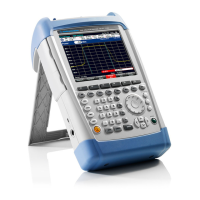Instrument Design and Functional Description R&S FSH
1145.5973.82 3.2 E-11
Description of the block diagram
The R&S FSH is a triple-conversion super-heterodyne receiver for the frequency range 100 kHz to
3 GHz. After signals are received, they are processed by the RF/IF board and the mainboard.
The RF/IF board contains the functions as described below.
Attenuator
The RF signal passes from the input connector RF INPUT to the programmable input attenuator, which
can be switched from 0 dB to 30 dB in increments of 10 dB. The circuitry is protected from overvoltage.
RF to IF conversion
The RF/IF board converts the received frequencies in the range 100 kHz to 3 GHz to the low 31.25 MHz
IF, which is digitized with 25 MHz before it is sent to the mainboard for digital processing. The RF/IF
board also includes the required local oscillators and associated frequency processing circuits. The unit
is housed in silver-plated aluminum packaging.
The input signal passes via the input attenuator and the lowpass filter to the first mixer. The lowpass
filter provides suppression of the image frequency (image = LO+ IF) to keep the conversion
unambiguous. In the 1st mixer the input signal is up-converted to an IF of 4031.25 MHz by means of the
first LO (4031.25 MHz to 7031.25 MHz). The mixer is followed by a low noise IF amplifier, which
compensates for the loss due to mixing. The signal then passes a filter with a 3-dB bandwidth of
approximately 400 MHz for filtering the first IF. The local oscillator frequency required for this conversion
is also generated on the board. This signal is generated by three VCOs synchronized to 100 MHz, which
in turn is synchronized to a Temperature Compensated 10-MHz Xtal Oscillator (TCXO). This TCXO is
electrically calibrated.
The signal from the 1st IF filter is converted to the 2nd IF of 831.25 MHz. The signal is routed to an
831.25 MHz filter with a 3-dB bandwidth of 20 MHz for further signal processing. The filter is followed by
the 3rd mixer, which converts to 31.25 MHz and utilizes an IF filter that has a -3-dB bandwidth of
approximately 2 MHz.
The frequency range above 3°GHz in the R&S FSH6 is converted via two additional mixers to a first IF
of 7231.25°MHz and to the same 2
nd
IF as in the FSH3 of 831.25 MHz. As LO signals the oscillator
signals of the FSH3 are doubled.

